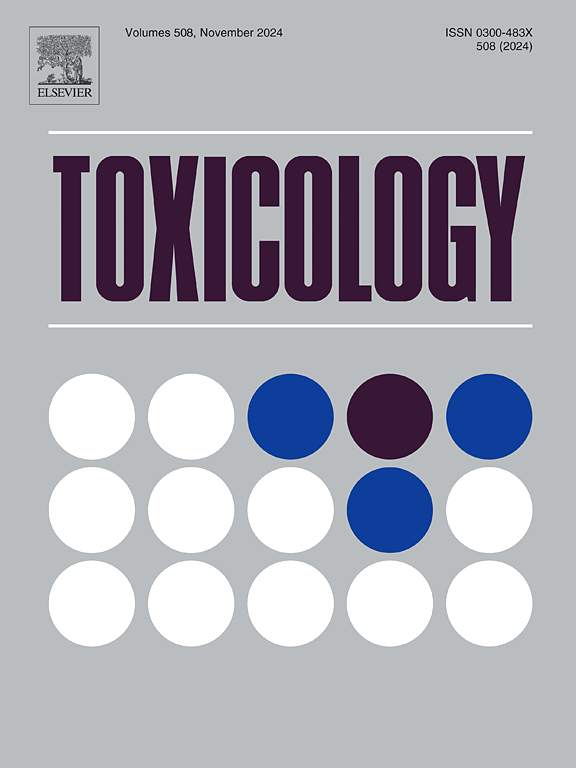Key role of extracellular vesicles in the induction of necroptosis and apoptosis by a mixture of polycyclic aromatic hydrocarbons in the context of a steatohepatitis-like state
IF 4.6
3区 医学
Q1 PHARMACOLOGY & PHARMACY
引用次数: 0
Abstract
A positive association between human exposure to environmental pollutants and progression from benign hepatic steatosis to advanced chronic liver diseases has been documented. Among chemicals found in air pollution, polycyclic aromatic hydrocarbons (PAHs) are of particular concern, due to their omnipresence in the environment. Ingestion of contaminated food is the primary route of exposure. Previous studies on the ability of PAHs to induce the pathological progression of liver steatosis have been limited to the analysis of individual PAHs. The aim of this study was therefore to examine the effects of a mixture of PAHs whose composition closely recapitulates that of contaminated food. The PAH mixture elicited both a steatohepatitis-like state in steatotic WIF-B9 hepatocytes (100 nM for 72 hours) and the progression of steatohepatitis in rats fed a lipid-enriched diet (0.8 mg/kg for 90 days). The PAH mixture induced transient necroptosis at 5 hours followed by a gradual increase in cellular apoptosis. PAH metabolism-dependent necroptosis appeared to be responsible for the development of the secondary apoptosis. Hepatocyte exposure induced a necroptosis-dependent release of extracellular vesicles (EVs), that appeared to be protective against necroptosis; however, those necroptotic EVs triggered apoptosis in recipient hepatocytes. Blocking of ASGR EV receptors with asialofetuin inhibited the interaction of EVs with hepatocytes and hence apoptosis. In conclusion, EV release seems to be crucial to avoid necroptosis, but inhibition of EV uptake can protect against apoptosis.
在脂肪性肝炎样状态下,细胞外囊泡在多环芳烃混合物诱导坏死性坏死和凋亡中的关键作用。
人类暴露于环境污染物与良性肝脂肪变性发展为晚期慢性肝病之间存在正相关。在空气污染中发现的化学物质中,多环芳烃(PAHs)由于在环境中无处不在而受到特别关注。摄入受污染的食物是主要的接触途径。以往关于多环芳烃诱导肝脏脂肪变性病理进展能力的研究仅限于对单个多环芳烃的分析。因此,这项研究的目的是检查多环芳烃混合物的影响,其成分与受污染食物的成分非常相似。多环芳烃混合物在脂肪变性的wi - b9肝细胞中引起脂肪性肝炎样状态(100nM,持续72小时),并在喂食富脂饮食(0.8mg/kg,持续90天)的大鼠中引起脂肪性肝炎的进展。多环芳烃混合物在5小时诱导短暂性坏死下垂,随后细胞凋亡逐渐增加。多环芳烃代谢依赖性坏死下垂似乎是继发性细胞凋亡发生的原因。肝细胞暴露诱导细胞外囊泡(EVs)的坏死依赖释放,这似乎对坏死有保护作用;然而,这些坏死性EVs引发受体肝细胞凋亡。用asialofetuin阻断ASGR EV受体可抑制EV与肝细胞的相互作用,从而抑制细胞凋亡。综上所述,EV的释放似乎对避免坏死下垂至关重要,但抑制EV的摄取可以防止细胞凋亡。
本文章由计算机程序翻译,如有差异,请以英文原文为准。
求助全文
约1分钟内获得全文
求助全文
来源期刊

Toxicology
医学-毒理学
CiteScore
7.80
自引率
4.40%
发文量
222
审稿时长
23 days
期刊介绍:
Toxicology is an international, peer-reviewed journal that publishes only the highest quality original scientific research and critical reviews describing hypothesis-based investigations into mechanisms of toxicity associated with exposures to xenobiotic chemicals, particularly as it relates to human health. In this respect "mechanisms" is defined on both the macro (e.g. physiological, biological, kinetic, species, sex, etc.) and molecular (genomic, transcriptomic, metabolic, etc.) scale. Emphasis is placed on findings that identify novel hazards and that can be extrapolated to exposures and mechanisms that are relevant to estimating human risk. Toxicology also publishes brief communications, personal commentaries and opinion articles, as well as concise expert reviews on contemporary topics. All research and review articles published in Toxicology are subject to rigorous peer review. Authors are asked to contact the Editor-in-Chief prior to submitting review articles or commentaries for consideration for publication in Toxicology.
 求助内容:
求助内容: 应助结果提醒方式:
应助结果提醒方式:


